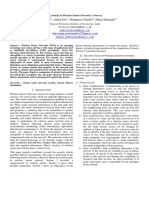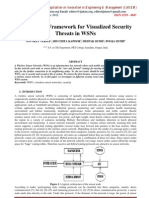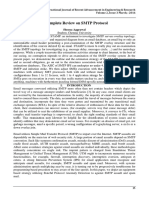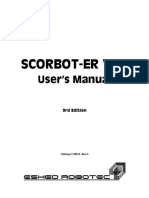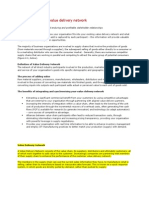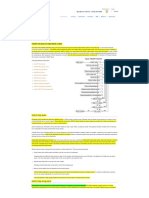Wireless Sensor Network Safety & Challenges
Wireless Sensor Network Safety & Challenges
Uploaded by
IJRAERCopyright:
Available Formats
Wireless Sensor Network Safety & Challenges
Wireless Sensor Network Safety & Challenges
Uploaded by
IJRAEROriginal Description:
Original Title
Copyright
Available Formats
Share this document
Did you find this document useful?
Is this content inappropriate?
Copyright:
Available Formats
Wireless Sensor Network Safety & Challenges
Wireless Sensor Network Safety & Challenges
Uploaded by
IJRAERCopyright:
Available Formats
International Journal of Recent Advancement in Engineering & Research
Volume 2, Issue 5 May; -2016
WIRELESS SENSOR NETWORK SAFETY & CHALLENGES
Vivek Sharma1, Manoj Tripathi2
1,2Allahabad University
Abstract - A Wireless Sensor Network (WSN) is a developing innovation and getting critical
consideration because of its boundless potential begins from residential application to combat zone.
Remote Sensor Networks(WSN) are a most difficult and rising innovation for the exploration
because of their essential degree in the field combined with their low handling power and related low
vitality. Today remote sensor systems are extensively utilized as a part of natural control, observation
undertakings, checking, following and controlling and so on. Sensor hubs are minor, shoddy,
dispensable and independent battery controlled PCs, known as "bits", which can acknowledge
contribution from an appended sensor, prepare this info information and transmit the outcomes
remotely to the travel organize. Because of the different uses of WSN in country security and
military, security is the significant issue to be dealt with. In this paper we examine about The blend
of these elements requests security for sensor systems at plan time to guarantee operation wellbeing,
mystery of delicate information, and protection for individuals in sensor situations. Communicate
validation is a basic security benefit in sensor systems; it permits a sender to communicate messages
to different hubs in a verified way. TESLA and multi-level TESLA have been proposed to give
such support of sensor systems.
Keywords-WSN, Security, Attacks, TESLA
I. INTRODUCTION
Remote sensor systems are gathering of hubs where every hub has its own sensor, processor,
transmitter and beneficiary and such sensors more often than not are minimal effort gadgets that play
out a particular sort of detecting errand. Being of ease such sensors are conveyed thickly all through
the range to screen particular occasion. The remote sensor arranges for the most part work out in the
open and uncontrolled range; consequently the security is a noteworthy test in sensor applications. A
sensor hub more often than not has one or a couple detecting segments, which sense physical wonder
(e.g., temperature) from its prompt environment, and a handling and correspondence segment, which
performs straightforward calculation on the detected information and speaks with base stations and
additionally different hubs through its quick neighbor hubs. The control hubs may assist prepare the
information gathered from sensor hubs, spread control orders to sensor hubs, and interface the
system to a conventional wired senders [1].
Essentially the real test for utilizing any proficient security conspire in remote sensor systems is
made by the extent of sensors, subsequently the preparing force, memory and kind of errands
anticipated from the sensors. We talk about these issues and difficulties in this paper. To address the
basic security issues in remote sensor systems we discuss cryptography and some different strategies
with respect to application layer.
II. APPLICATION OF WSN
Remote Sensor Nodes are utilized as a part of limitless zone. Here we finish up principle region of
the utilizations of WSN.
A. The Military Applications
The military use of sensor hubs incorporates combat zone reconnaissance and observing, directing
frameworks of insightful rockets and location of assault by weapons of mass devastation [4].
B. The Medical Application
15
International Journal of Recent Advancement in Engineering & Research
Volume 2, Issue 5 May; -2016
Sensors can be greatly helpful in patient analysis and observing [9]. Patients can wear little sensor
gadgets that screen their physiological information, for example, heart rate or circulatory strain [4].
C. Industrial Applications
It incorporates modern detecting and diagnostics. For instance machines, production line, supply
chains and so on [4]
III. ATTACKS ON WSN
Remote sensor systems utilize layered design like wired system engineering. In view of every last
layer WSN faces diverse assaults .The different assaults abuse the affectability and security of WSN.
The different assaults are clarified underneath.
A. Denial of service
This sort of assault comes about into making inaccessible the assets to their expected clients. For
instance hub A sends demand to hub B for correspondence and hub B sends recognize to hub A yet
A continues sending solicitation to B consistently. Therefore B is not ready to speak with some other
hubs and subsequently gets to be inaccessible to every one of them.
Refusal of administration assault may likewise happen at physical layer by sticking (by
communicating system) and/or altering (adjustment or manufacture) of the parcel. In Link Layer it is
by creating impact information, weariness of assets and shamefulness being used of systems. In
system layer, it happens by method for disregarding and the ravenousness of parcels coming about
into way disappointment. In transport layer, DOS assault happens because of flooding and desynchronization. A large portion of foreswearing of administration assaults might be anticipated by
effective verification and recognizable proof systems.
B. Sybil attack
In this assault the assailant gets illicitly various characters on one hub. By this, the aggressor for the
most part influences the directing component. Sybil assaults are by and large averted by approval
techniques.[1]
Figure 1: Sybil Attack
B. Node Capturing
A particular sensor might be captured, and information stored on it might be obtained by an
adversary.
16
International Journal of Recent Advancement in Engineering & Research
Volume 2, Issue 5 May; -2016
C. Blackhole / Sinkhole Attack:
In this kind of assault, aggressor places himself in a system with high capacity assets (high handling
force and high band width) by which it generally makes most limited way. Therefore, all information
goes through assailant's hub [1]. Sinkhole assaults are hard to counter in light of the fact that steering
data supplied by a hub is hard to confirm.
Figure 2: Blackhole/S sinkhole Attack
D. Hello flood Attack
This is one of the easiest assault in remote sensor organizes in which assailant communicates
HELLO parcels with high transmission energy to sender or beneficiary. The hubs accepting the
messages expect that the sender hub is closest to them and sends parcels by this hub. [1] By this
assault blockage happens in the system. This is a particular kind of DOS. Blocking methods are
utilized to counteract Hello Flood attacks.[1]
E. Wormhole Attack
In this sort of assault, the assailant utilizes burrowing component to set up himself between them by
confounding the directing convention. Figure 4 demonstrates component of wormhole assault let Y
needs to send information by method for broadcasting before sending the information to discover
way. However the assailant presents himself as a hub X and sends affirmation to Y. Y sends
information to X that is gotten by and sends that information to X by burrowing, concealing its own
particular personality. For this situation X and Y are not in a solitary bounce but rather they think
they are in a one jump run. The aggressor therefore may obliterate security by interference, block
attempt, change and creation. [1]
17
International Journal of Recent Advancement in Engineering & Research
Volume 2, Issue 5 May; -2016
Figure 3: Wormhole Attack
F. Hello flood Attack
This is one of the most straightforward assault in remote sensor organizes in which assailant
communicates HELLO bundles with high transmission energy to sender or beneficiary. The hubs
getting the messages expect that the sender hub is closest to them and sends parcels by this hub. By
this assault clog happens in the system. This is a particular kind of DOS. Blocking procedures are
utilized to avert Hello Flood assaults.
G. Passive Information Gathering
An interloper with a suitably intense collector and very much planned recieving wire can without
much of a stretch pick off the information stream. Capture of the messages containing the physical
areas of sensor hubs permits an assailant to find the hubs and devastate them. Other than the areas of
sensor hubs, an enemy can watch the application particular substance of messages including message
IDs, timestamps and different fields.
H. False or Malicious Node
Most of the attacks against security in wireless sensor networks are caused by the insertion of
false information by the compromised nodes within the network.
II. PROPOSED SECURITY SCHEMES AND RELATED WORK
A. Cryptography
The encryption-decoding strategies concocted for the customary wired systems are not achievable to
be connected specifically for the remote systems and specifically for remote sensor systems. WSNs
comprise of modest sensors which truly experience the ill effects of the absence of preparing,
memory and battery control. Applying any encryption conspire requires transmission of additional
bits, thus additional preparing, memory furthermore, battery control which are critical assets for the
sensors' life span. Applying the security instruments, for example, encryption could likewise expand
postponement, jitter and parcel misfortune in remote sensor systems .Moreover, some basic inquiries
emerge while applying encryption plans to WSNs like, how the keys are produced or spread. How
the keys are overseen, repudiated, allocated to another sensor added to the system or reestablished
for guaranteeing strong security for the organize.
B. SPINS security building blocks
We plan two security building pieces: SNEP and TESLA.TESLA gives confirmation to
information communicate. We bootstrap the security for both components with a mutual mystery key
between every hub and the base station.
1. SNEP
SNEP gives various extraordinary focal points. To start with, it has low correspondence overhead; it
just includes 8 bytes for each message. Second, in the same way as other cryptographic conventions
it utilizes a counter, yet we abstain from transmitting the counter esteem by keeping state at both end
focuses. Third, SNEP accomplishes semantic security, a solid security property which keeps
meddlers from inducing the message content from the scrambled message (see talk beneath). At last,
similar straightforward and proficient convention likewise gives us information confirmation, replay
assurance, and feeble message freshness. Information privacy is a standout amongst the most
fundamental security primitives and it is utilized as a part of practically every security
convention. A basic type of secrecy can be accomplished through encryption, however immaculate
encryption is not adequate. Another vital security property is semantic security, which guarantees
that a busybody has no data about the plaintext, regardless of the possibility that it sees various
18
International Journal of Recent Advancement in Engineering & Research
Volume 2, Issue 5 May; -2016
encryptions of the same
plaintext. For instance, regardless of the possibility that an aggressor has an encryption of a 0 bit and
an encryption of a 1 bit, it won't help it recognize whether another encryption is an encryption of 0 or
1. An essential strategy to accomplish this is randomization: Before scrambling the message with a
fastening encryption work (i.e. DES-CBC), the sender goes before the message with an arbitrary
piece string. This keeps the aggressor from construing the plaintext of scrambled messages on the off
chance that it knows plaintextcipher content sets encoded with similar key. Sending the randomized
information over a remote channel, in any case, requires
more vitality. So we develop another cryptographic instrument that accomplishes semantic security
with no extra transmission overhead. We utilize two counters shared by the gatherings (one for every
course of correspondence) for the square figure in counter mode (CTR) A customary approach
to deal with the counters is to send the counter alongside every message. In any case, since we are
utilizing sensors and the conveying parties share the counter and addition it after every square, the
sender can spare vitality by sending the message without the counter. Toward the end of this area we
portray a counter trade convention, which the conveying parties use to synchronize (or resynchronize) their counter values. To accomplish two-party verification and information honesty, we
utilize a message validation code (MAC).The finish message that, A sends to B is:
AB: (D){KAB,C}, MAC(K|AB,C|| (D){KAB,CA})
Semantic security is provided with the counter each message is encrypted differently. Data Freshness
is provided with the help of counter that each data is different.
2. TESLA overview
Verified communicate requires a hilter kilter instrument; generally any bargained recipient could
produce messages from the sender. Tragically, topsy-turvy cryptographic instruments have high
calculation correspondence, and capacity overhead, making their utilization on asset obliged gadgets
unfeasible. TESLA defeats this issue by presenting asymmetry through a
deferred divulgence of symmetric keys, which brings about a productive communicate verification
conspire. We first clarify TESLA for the situation where the base station communicates confirmed
data to the hubs. Later we examine the situation where the hubs are the sender. TESLA requires
that
the base station and hubs be freely time synchronized, and every hub knows an upper bound on the
most extreme synchronization mistake. [2]
To send a confirmed parcel, the construct station processes a MAC in light of the bundle with a key
that is mystery by then. At the point when a hub gets a parcel, it can check that the comparing MAC
key was not yet uncovered by the construct station (based with respect to its inexactly synchronized
clock, its most extreme synchronization blunder, and the time plan at which keys are unveiled). Since
an accepting hub is guaranteed that the MAC key is known just by the base station, the getting hub is
guaranteed that no enemy could have adjusted the bundle in travel [2]. The hub stores the parcel in a
cushion. At the season of key revelation, the base station communicates the confirmation key to
every one of the recipients. At the time of key revelation, the base station communicates the check
key to all beneficiaries. At the point when a hub gets the uncovered key, it can check the accuracy of
the key (which we clarify beneath). In the event that the key is right, the hub can now utilize it to
19
International Journal of Recent Advancement in Engineering & Research
Volume 2, Issue 5 May; -2016
confirm the parcel put away in its support.
Figure 4: Overview of TESLA mechanism
3. Multilevel TESLA Mechanism
A multi-level TESLA procedure is proposed to ex-tend the capacities of TESLA [3, 4]. The
fundamental thought is to build a multi-level TESLA structure, where any more elevated amount
TESLA example is just used to verify the responsibilities of its quick lower level ones and the least
level TESLA occurrences are really used to confirm the information parcels. This expansion
empowers the first TESA to have the capacity to cover quite a while period and bolster countless
[3].Assume a sensor organize application requires TESLA cases, which might be utilized by
various senders amid various timeframes. For accommodation, accept m = 2 k, where k is
a whole number. Before sending, the focal server pre processes TESLA occurrences, each of which
is doled out a one of a kind, whole number esteemed ID somewhere around 1 and m. For
presentation, indicate the parameters (i.e., the key chain responsibility, beginning time, length of
each TESLA interim, and so on.) of the ith TESLA example as Si. Assume the focal server has a
hash work H. The focal server then processes Ki = H (Si) for all i {1,..., m}, and develops a Merkle
tree [8] utilizing {K1,...,Km} as leaf hubs. In particular, K1,...,Km are masterminded as leaf hubs of
a full paired tree, and each non-leaf hub is registered by applying H to the link of its two youngsters
hubs.
We allude to such a Merkle tree as a parameter dissemination tree of parameters {S1,...,Sm}. Figure
1 demonstrates a parameter dissemination tree for eight TESLA examples, where K1 = H(S1), K12
= H(K1||K2), K14 = H(K12||K34), and so on. The focal server additionally develops a parameter
testament for each TESLA occurrence. The declaration for the ith TESLA occurrence comprises
of the set Si of parameters and the qualities relating to the kin of the hubs on the way from the ith
leaf hub to the root in the parameter appropriation tree.
Figure 5: Parameter Distribution Tree
20
International Journal of Recent Advancement in Engineering & Research
Volume 2, Issue 5 May; -2016
For instance, the parameter testament for the third TESLA example in Figure 5 is ParaCert3 =
{S3,K4,K12,K58}. For every sender that will utilize a given TESLA occurrence, the focal server
disperses the TESLA key chain (or identically, the arbitrary number used to create the key chain)
and the relating parameter testament to the hub. The focal server additionally pre-conveys the base of
the parameter dissemination tree (e.g., K18 in Figure 1) to standard sensor hubs, which are possibly
beneficiaries of communicate messages. At the point when a sender needs to build up a validated
communicate channel utilizing the ith TESLA example (amid a foreordained timeframe), it
communicates a message containing the parameter declaration ParaCerti. Every beneficiary can
promptly verify it with the pre-conveyed foundation of the parameter dissemination tree. For
instance, if ParaCert3 = {S3,K4,K12,K58} is utilized, a beneficiary can promptly confirm it by
checking whether H(H(K12||H(H(S3)||K4))||K58) levels with the pre-disseminated root esteem K18.
Subsequently, every one of the collectors can get the verified parameters of this TESLA
occurrence, and the sender may utilize it for communicate validation.
III. COMPARISON Multi- level TESLA And TESLA
Contrasted and the multi-level TESLA plots, the most critical pick up of the proposed approach is
the expulsion of the confirmation delay in appropriating the TESLA parameters. The multi-level
TESLA plans are liable to DOS assaults against the conveyance of TESLA parameters as a result
of the validation delay [3]. In particular, collectors can't verify parameter circulation messages
instantly subsequent to getting them, and in this manner need to support such messages. An
aggressor may send a lot of sham messages to expend beneficiaries' cradles and subsequently keep
the beneficiary from sparing the credible message. To moderate or annihilation such DOS assaults,
the multi-level TESLA conspires either utilize copied duplicates of appropriation messages
alongside a multi-support, irregular determination system, or require significant pre-calculation at the
sender.
Interestingly, the proposed approach does not have these issues. With the proposed approach, senders
may at present copy parameter appropriation messages to manage correspondence disappointments.
How-ever, not at all like multi-level TESLA plots, a sender does not need to rival pernicious
aggressors, since it can promptly confirm the parameter dispersion message as opposed to keeping it
in the support for future validation. As such, with the proposed approach, it is adequate for a
recipient to get one duplicate of every parameter dispersion message.
IV. CONCLUSION
There are sure assaults on WSN, contingent on various layers. This paper gives diagram of remote
sensor organizes, their security issues and non specific arrangements. A few utilizations of remote
Sensor organize require a safe correspondence (like combat zone environment). Conventional
arrangements are talked about which averts WSN security on application layer. TESLA plan is for
single sender and numerous collectors however multilevel TESLA is for various senders and
beneficiaries both.
REFERENCES
[1]
[2]
[3]
[4]
[5]
[6]
Abhishek Pandey and R.C. Tripathi, A Survey on Wireless Sensor Networks Security ,in International Journal
of Computer Applications (0975 8887) Volume 3 No.2, June 2010
ADRIAN PERRIG, ROBERT SZEWCZYK, J.D. TYGAR, VICTOR WEN and DAVID E. CULLER , SPINS:
Security Protocols for Sensor Networks,In [ACM Journal of] Wireless Networks, 8:5,September 2002, pp. 521 534
Donggang Liu Peng Ning Sencun Zhu Sushil Jajodia , A Tree-Based -TESLA Broadcast Authentication for
Sensor Networks, in Proceedings of the 10th Annual Network and Distributed System Security
Symposium (NDSS03), Febru- ary 2003, pp. 263276.
Kalpana Sharma and M K Ghose, Wireless Sensor Networks: An Overview on its Security Threats in IJCA
Special Issue on Mobile Ad-hoc Networks MANETs, 2010
Al-Sakib Khan Pathan., Hyung-Woo Lee and Choong Seon Hong, Security in Wireless Sensor Networks:
Issues and Challenges,in Feb. 20-22, 2006 ICACT2006
A.D. Wood and J.A. Stankovic, (2002) Denial of Service in Sensor Networks, Computer, vol. 35, no. 10, 2002,
21
International Journal of Recent Advancement in Engineering & Research
Volume 2, Issue 5 May; -2016
[7]
[8]
[9]
[10]
[11]
pp. 54 62
D. Liu and P. Ning, Multi-level TESLA: Broadcast authentication for distributed sensor networks, ACM
Transac- tions in Embedded Computing Systems (TECS), vol. 3, no. 4, 2004.
Karlof, N. Sastry, Y. Li, A. Perrig, and J. Tygar, Distillation codes and applications to dos resistant multicast
authentication, in Proc. 11th Network and Distributed Systems Security Symposium (NDSS), 2004.
Feng Zhao,Leonidas Guibas,,Wireless Sensor Networks, Morgan Kaufmann Publications.
R. Merkle, Protocols for public key cryptosystems, in Proceedings of the IEEE Symposium on Research in
Secu- rity and Privacy, Apr 1980.
Applications of Wireless Applications of Wireless Sensor Networks Sensor Networks Kuei-Ping Shih,
http://wireless.cs.tku.edu.tw/~kps
22
You might also like
- Analysis of Security Protocols in Wireless Sensor Network: Ritu Sharma Yogesh ChabaDocument7 pagesAnalysis of Security Protocols in Wireless Sensor Network: Ritu Sharma Yogesh ChabaHiran VNNo ratings yet
- Aboelaze, M and Aloul, FDocument15 pagesAboelaze, M and Aloul, Fedscott66No ratings yet
- An Algorithmic Framework For Robust Access Control in Wireless Sensor NetworksDocument8 pagesAn Algorithmic Framework For Robust Access Control in Wireless Sensor NetworksChris TienNo ratings yet
- A Survey of Attacks, Security Mechanisms and Challenges in Wireless Sensor NetworksDocument9 pagesA Survey of Attacks, Security Mechanisms and Challenges in Wireless Sensor NetworksmarriedmanvnNo ratings yet
- International Journal of Engineering Research and Development (IJERD)Document8 pagesInternational Journal of Engineering Research and Development (IJERD)IJERDNo ratings yet
- Wireless Sensor Networks: Security Issues, Challenges and SolutionsDocument9 pagesWireless Sensor Networks: Security Issues, Challenges and SolutionsMansiNo ratings yet
- Dawwsen: A Defense Mechanism Against Wormhole Attacks in Wireless Sensor NetworksDocument10 pagesDawwsen: A Defense Mechanism Against Wormhole Attacks in Wireless Sensor NetworksAzhagu SubhaNo ratings yet
- IJTC201603001-Detecting Byzantine Attack Using Wireless Sensor NetworkDocument8 pagesIJTC201603001-Detecting Byzantine Attack Using Wireless Sensor NetworkInternational Journal of Technology and Computing (IJTC)No ratings yet
- A Survey On Comparison of Secure Routing Protocols in Wireless Sensor NetworksDocument5 pagesA Survey On Comparison of Secure Routing Protocols in Wireless Sensor NetworksWARSE JournalsNo ratings yet
- InTech-Security and Privacy in Wireless Sensor NetworksDocument24 pagesInTech-Security and Privacy in Wireless Sensor NetworksYung_JoCNo ratings yet
- 218 857 2 PBDocument5 pages218 857 2 PBDr Aditya GoelNo ratings yet
- A A C W S N: Ttacks ND Ounterattacks ON Ireless Ensor EtworksDocument15 pagesA A C W S N: Ttacks ND Ounterattacks ON Ireless Ensor EtworksLuis Ramon PasatoNo ratings yet
- Security in Wireless Sensor Networks: Comparative StudyDocument11 pagesSecurity in Wireless Sensor Networks: Comparative StudyAnonymous Gl4IRRjzNNo ratings yet
- Security Concepts and Sybil Attack Detection in Wireless Sensor NetworksDocument8 pagesSecurity Concepts and Sybil Attack Detection in Wireless Sensor NetworksInternational Journal of Application or Innovation in Engineering & ManagementNo ratings yet
- Deepali Virmani, Ankita Soni, Shringarica Chandel, Manas HemrajaniDocument8 pagesDeepali Virmani, Ankita Soni, Shringarica Chandel, Manas HemrajaniTeferi KassaNo ratings yet
- Routing Attacks in Wireless Sensor NetworksDocument5 pagesRouting Attacks in Wireless Sensor NetworksIJIRSTNo ratings yet
- Phonehome PaperDocument10 pagesPhonehome PaperThomas Fox-BrewsterNo ratings yet
- Optimal Malware Attack and Defense in Mobile Wireless NetworksDocument4 pagesOptimal Malware Attack and Defense in Mobile Wireless Networkssresearcher7No ratings yet
- LEDS - An Innovative Corridor of Data Security in WSNDocument5 pagesLEDS - An Innovative Corridor of Data Security in WSNEditor IJRITCCNo ratings yet
- A Security Model For WSNDocument6 pagesA Security Model For WSNAn HưngNo ratings yet
- Module 3Document63 pagesModule 3Ritu ParnaNo ratings yet
- A Proposed Framework For Visualized Security Threats in WsnsDocument6 pagesA Proposed Framework For Visualized Security Threats in WsnsInternational Journal of Application or Innovation in Engineering & ManagementNo ratings yet
- Analysis of Wireless Sensor NetworksDocument5 pagesAnalysis of Wireless Sensor NetworksesatjournalsNo ratings yet
- Detection of Sinkhole Attack in Wireless Sensor Network: 1.1problem StatementDocument12 pagesDetection of Sinkhole Attack in Wireless Sensor Network: 1.1problem StatementHarry SingNo ratings yet
- Saddle-Point - Stratdkjscnre - AttackDocument14 pagesSaddle-Point - Stratdkjscnre - AttackAhmed TalbiNo ratings yet
- Safety in WSN - TypesOfAttacksAndSolutionsDocument8 pagesSafety in WSN - TypesOfAttacksAndSolutionsJoséNo ratings yet
- Lightweight Intrusion Detection For WireDocument21 pagesLightweight Intrusion Detection For WireIsmail MainboyNo ratings yet
- Review On Hello Flood Attack in Wireless Sensor NetworksDocument3 pagesReview On Hello Flood Attack in Wireless Sensor NetworksIJIRSTNo ratings yet
- Unearthing The Compromised Nodes and Restoring Them in Wireless Sensor NetworkDocument6 pagesUnearthing The Compromised Nodes and Restoring Them in Wireless Sensor NetworkInternational Organization of Scientific Research (IOSR)No ratings yet
- Security Issues in Wireless Sensor Networks: Tanveer Zia and Albert ZomayaDocument4 pagesSecurity Issues in Wireless Sensor Networks: Tanveer Zia and Albert ZomayaAdarasupally ShivaramakrishnaNo ratings yet
- Analyze Attacks and VulnerabilitiesDocument18 pagesAnalyze Attacks and VulnerabilitiesrajunairNo ratings yet
- Security Issues in Wireless Sensor NetworkDocument21 pagesSecurity Issues in Wireless Sensor NetworkVikas PsNo ratings yet
- Xiaojiangdu 2008Document7 pagesXiaojiangdu 2008natuan6a3No ratings yet
- Vol3 Issue2Document46 pagesVol3 Issue2Ehsan SheikhNo ratings yet
- "MY APPS"-Android Application Security Software Using Grid Security Infrastructure (GSI)Document51 pages"MY APPS"-Android Application Security Software Using Grid Security Infrastructure (GSI)Prabu RajsekarNo ratings yet
- Abdullah Et Al. - 2018 - Intrusion Detection of DoS Attacks in WSNsDocument6 pagesAbdullah Et Al. - 2018 - Intrusion Detection of DoS Attacks in WSNsIshmael OkineNo ratings yet
- Ijret20150414004 PDFDocument4 pagesIjret20150414004 PDFManoj VarmaNo ratings yet
- A Survey On Secure Clustering Protocols 2018Document11 pagesA Survey On Secure Clustering Protocols 2018hhakim32No ratings yet
- W S N S A: Ireless Ensor Etwork Ecurity NalysisDocument10 pagesW S N S A: Ireless Ensor Etwork Ecurity Nalysistrilok4391No ratings yet
- Paperv5 Acm FormatDocument31 pagesPaperv5 Acm FormatAldar ChanNo ratings yet
- INSE6190 Final ReportDocument11 pagesINSE6190 Final ReportDilipanNo ratings yet
- Security and Key Management Challenges Over WSN (A Survey)Document20 pagesSecurity and Key Management Challenges Over WSN (A Survey)ijcsesNo ratings yet
- Wireless Sensor Network Security Model Using Zero Knowledge ProtocolDocument5 pagesWireless Sensor Network Security Model Using Zero Knowledge ProtocolIOSRJEN : hard copy, certificates, Call for Papers 2013, publishing of journalNo ratings yet
- 1.1 Overview of Wireless NetworksDocument41 pages1.1 Overview of Wireless NetworkspriyaNo ratings yet
- Security Enhancement in Data Propagation For Wireless NetworkDocument10 pagesSecurity Enhancement in Data Propagation For Wireless NetworkZainlab UddinNo ratings yet
- Various OSI Layer Attacks and Countermeasure To Enhance The Performance of WSNs During Wormhole AttackDocument6 pagesVarious OSI Layer Attacks and Countermeasure To Enhance The Performance of WSNs During Wormhole AttackIDESNo ratings yet
- Detection Techniques OF Selective Forwarding Attacks IN Wireless Sensor Networks: A SurveyDocument6 pagesDetection Techniques OF Selective Forwarding Attacks IN Wireless Sensor Networks: A SurveyGarry SandhuNo ratings yet
- A Survey of Intrusion Detection Systems in Wireless Sensor NetworksDocument17 pagesA Survey of Intrusion Detection Systems in Wireless Sensor NetworksAnil NaikNo ratings yet
- Secure and Efficient Sink Node Location Privacy Technique in WSNDocument6 pagesSecure and Efficient Sink Node Location Privacy Technique in WSNInternational Journal of Application or Innovation in Engineering & ManagementNo ratings yet
- A Swarm Based Defense Technique For Jamming Attacks in Wireless Sensor NetworksDocument6 pagesA Swarm Based Defense Technique For Jamming Attacks in Wireless Sensor NetworksAs HelsNo ratings yet
- A Review On Anomaly Detection Techniques For Wireless Sensor NetworksDocument6 pagesA Review On Anomaly Detection Techniques For Wireless Sensor NetworksInternational Journal of Application or Innovation in Engineering & ManagementNo ratings yet
- Intrusion Detection: An Energy Efficient Approach in Heterogeneous WSNDocument43 pagesIntrusion Detection: An Energy Efficient Approach in Heterogeneous WSNSantosh DineshNo ratings yet
- Ijet V3i6p69Document6 pagesIjet V3i6p69International Journal of Engineering and TechniquesNo ratings yet
- Survey On Approaches To Detect Sinkhole Attacks in Wireless Sensor NetworksDocument6 pagesSurvey On Approaches To Detect Sinkhole Attacks in Wireless Sensor NetworksWARSE JournalsNo ratings yet
- Secured Aodv To Protect WSN Against Malicious IntrusionDocument13 pagesSecured Aodv To Protect WSN Against Malicious IntrusionAIRCC - IJNSANo ratings yet
- A Novel Security Framework Using Trust and Fuzzy Logic in ManetDocument15 pagesA Novel Security Framework Using Trust and Fuzzy Logic in ManetijdpsNo ratings yet
- Unit 5 - CRDocument44 pagesUnit 5 - CRYuvashri SelvamNo ratings yet
- Enhanced Three Tier Security Architecture For WSN Against Mobile Sink Replication Attacks Using Mutual Authentication SchemeDocument13 pagesEnhanced Three Tier Security Architecture For WSN Against Mobile Sink Replication Attacks Using Mutual Authentication SchemeJohn BergNo ratings yet
- Base PApertDocument29 pagesBase PApertSiva RajNo ratings yet
- Hardware Supply Chain Security: Threat Modelling, Emerging Attacks and CountermeasuresFrom EverandHardware Supply Chain Security: Threat Modelling, Emerging Attacks and CountermeasuresBasel HalakNo ratings yet
- Survey On Use of Bet in Medical Diagnosis As Support System: Kashvi MunjaparaDocument4 pagesSurvey On Use of Bet in Medical Diagnosis As Support System: Kashvi MunjaparaIJRAERNo ratings yet
- A Survey On Intrusion Finding SystemsDocument5 pagesA Survey On Intrusion Finding SystemsIJRAERNo ratings yet
- Review of Cache Problem With ARP: S.Balasubrahmanyam, P BalasubrahmanyamDocument3 pagesReview of Cache Problem With ARP: S.Balasubrahmanyam, P BalasubrahmanyamIJRAERNo ratings yet
- A Review Paper On Simple Network Management Protocol: Kumar SatakarniDocument5 pagesA Review Paper On Simple Network Management Protocol: Kumar SatakarniIJRAERNo ratings yet
- Captcha For Security in WWWDocument3 pagesCaptcha For Security in WWWIJRAERNo ratings yet
- Enhanced Method For Huge Data Insertion: AbstractDocument4 pagesEnhanced Method For Huge Data Insertion: AbstractIJRAERNo ratings yet
- Multicast Routing Protocols: A Survey: Student, Sikkim Manipal UniversityDocument4 pagesMulticast Routing Protocols: A Survey: Student, Sikkim Manipal UniversityIJRAERNo ratings yet
- High Speed Mobile Wireless TechnologyDocument5 pagesHigh Speed Mobile Wireless TechnologyIJRAERNo ratings yet
- Study of WSN Clustering & Routing ProtocolDocument5 pagesStudy of WSN Clustering & Routing ProtocolIJRAERNo ratings yet
- Surveying & Evaluating Various Multicasting Protocols: Vihang PatelDocument4 pagesSurveying & Evaluating Various Multicasting Protocols: Vihang PatelIJRAERNo ratings yet
- Review On Protocols For Routing in Network With Sensing CapacityDocument4 pagesReview On Protocols For Routing in Network With Sensing CapacityIJRAERNo ratings yet
- A Complete Review On SMTP Protocol: Sheena Aggrawal AbstractDocument8 pagesA Complete Review On SMTP Protocol: Sheena Aggrawal AbstractIJRAERNo ratings yet
- 2 - Arp Protocol Survey PPRDocument3 pages2 - Arp Protocol Survey PPRIJRAERNo ratings yet
- Modeling Radar On Global Positioning System: Department of Electronics, RTU, IndiaDocument7 pagesModeling Radar On Global Positioning System: Department of Electronics, RTU, IndiaIJRAERNo ratings yet
- Review On High Bandwidth Network For Man: Praita BhattDocument7 pagesReview On High Bandwidth Network For Man: Praita BhattIJRAERNo ratings yet
- Router Level Load Matching Tools in WMN - A SurveyDocument2 pagesRouter Level Load Matching Tools in WMN - A SurveyIJRAERNo ratings yet
- Black Hole Attack in Wireless Mobile Adhoc NetworksDocument4 pagesBlack Hole Attack in Wireless Mobile Adhoc NetworksIJRAERNo ratings yet
- Arp, Its Challenges & Solutions: Study: Mohit JaniDocument6 pagesArp, Its Challenges & Solutions: Study: Mohit JaniIJRAERNo ratings yet
- Working of Asynchronous Teller Machine With Parent and Foreign OrganizationDocument4 pagesWorking of Asynchronous Teller Machine With Parent and Foreign OrganizationIJRAERNo ratings yet
- Private Cloud Server Applicationsfor Data StorageDocument5 pagesPrivate Cloud Server Applicationsfor Data StorageIJRAERNo ratings yet
- Review On Extraction of Information From Stream Data Using Data Mining TechniqueDocument7 pagesReview On Extraction of Information From Stream Data Using Data Mining TechniqueIJRAERNo ratings yet
- Implement Full Duplex Chat Using TcpipDocument3 pagesImplement Full Duplex Chat Using TcpipIJRAERNo ratings yet
- Green Computing A Global Requirement - A ReviewDocument4 pagesGreen Computing A Global Requirement - A ReviewIJRAERNo ratings yet
- Big Data Scope and ChallengesDocument3 pagesBig Data Scope and ChallengesIJRAERNo ratings yet
- Deepsea WSN Working: A Study: Pratiksha JaniDocument5 pagesDeepsea WSN Working: A Study: Pratiksha JaniIJRAERNo ratings yet
- A Survey of Prim AlgorithmDocument3 pagesA Survey of Prim AlgorithmIJRAERNo ratings yet
- A Review On Clustering TechniquesDocument4 pagesA Review On Clustering TechniquesIJRAERNo ratings yet
- Commendation Generation by Homomorphic EncryptionDocument4 pagesCommendation Generation by Homomorphic EncryptionIJRAERNo ratings yet
- Telephone/Mobile Numbers List of Water Resources Department: SA To ChairpersonDocument10 pagesTelephone/Mobile Numbers List of Water Resources Department: SA To Chairpersonmanmohansingh271311No ratings yet
- Micros CRPDocument278 pagesMicros CRPReynaldo MacarioNo ratings yet
- SCORBOT ER VplusDocument144 pagesSCORBOT ER VpluszxcvbnmNo ratings yet
- Omar El-Adany: Education and TrainingDocument3 pagesOmar El-Adany: Education and Trainingmadooo94.awNo ratings yet
- Strengthening Your Value Delivery NetworkDocument11 pagesStrengthening Your Value Delivery NetworkSwapnil ChodankerNo ratings yet
- Bit ResumeDocument2 pagesBit Resumesiddhu1150No ratings yet
- IP II Module ChalaDocument55 pagesIP II Module ChalaKALEAB TESFAHUN SISAYNo ratings yet
- 98995-251555 - Levin Kandakudy - Mar 13, 2024 406 PM - Combating Organized CybercrimeDocument2 pages98995-251555 - Levin Kandakudy - Mar 13, 2024 406 PM - Combating Organized Cybercrimeliberjan00044No ratings yet
- Boot Management & Process ManagementDocument10 pagesBoot Management & Process ManagementAqsaNo ratings yet
- HAZOP (Hazard and Operability) Study: Home About Consulting Training Software Technical Blog ContactDocument5 pagesHAZOP (Hazard and Operability) Study: Home About Consulting Training Software Technical Blog ContactAlbertoNo ratings yet
- TPS23861 Power-On Considerations: Application ReportDocument6 pagesTPS23861 Power-On Considerations: Application Reportsj huangNo ratings yet
- UHGDocument6 pagesUHGKamaraju DaviliNo ratings yet
- FinalDocument - STUDENT MANAGEMENT SYSTEMDocument67 pagesFinalDocument - STUDENT MANAGEMENT SYSTEMMARIELLA TRACY BANDONGNo ratings yet
- Internship Report On: An Overview of Daraz Bangladesh and Its Operations From Vendor To Customer'Document41 pagesInternship Report On: An Overview of Daraz Bangladesh and Its Operations From Vendor To Customer'Hannan ZahidNo ratings yet
- Introducing Small Basic-1 PDFDocument69 pagesIntroducing Small Basic-1 PDFnilaNo ratings yet
- Computer Science Investigatory Project (LIBRARY MANAGEMENT SYSTEM) CLASS 12 CBSEDocument30 pagesComputer Science Investigatory Project (LIBRARY MANAGEMENT SYSTEM) CLASS 12 CBSEakash sathishNo ratings yet
- RPA Cheat Sheet PDFDocument1 pageRPA Cheat Sheet PDFearnestgoh3635No ratings yet
- Introduction To Simulation: by Ajay ChedudoopDocument18 pagesIntroduction To Simulation: by Ajay ChedudoopPallavi DeorukhkarNo ratings yet
- Project 2Document42 pagesProject 2VanshikaNo ratings yet
- Envelope Theorem and Identities (Good)Document17 pagesEnvelope Theorem and Identities (Good)sadatnfsNo ratings yet
- Lesson 6: Additional Views: Exercise 6a: NarrativesDocument10 pagesLesson 6: Additional Views: Exercise 6a: NarrativesnareshreddyguntakaNo ratings yet
- Image Segmentation, Representation & DescriptionDocument42 pagesImage Segmentation, Representation & DescriptionEshan JainNo ratings yet
- Network Layer Protocols: Chapter - 4Document156 pagesNetwork Layer Protocols: Chapter - 4AviralNo ratings yet
- Ux Style FrameworksDocument246 pagesUx Style Frameworksrashid.e.abdounNo ratings yet
- Employment Application Form - FillableDocument1 pageEmployment Application Form - FillableRamon SaldiasNo ratings yet
- Business Rules vs. Calc ScriptDocument3 pagesBusiness Rules vs. Calc ScriptMax100% (1)
- A Review of LCC-HVDC and VSC-HVDC Technologies and Applications - 2016Document7 pagesA Review of LCC-HVDC and VSC-HVDC Technologies and Applications - 2016M8ow6fNo ratings yet
- Department of Electrical Engineering EE365L: Communication SystemsDocument16 pagesDepartment of Electrical Engineering EE365L: Communication SystemsAbrahan ShahzadNo ratings yet
- Mike RoiseDocument6 pagesMike Roisevrms1808No ratings yet
- Monthly Remittance Form: of Creditable Income Taxes Withheld (Expanded)Document2 pagesMonthly Remittance Form: of Creditable Income Taxes Withheld (Expanded)Derick MoranteNo ratings yet














